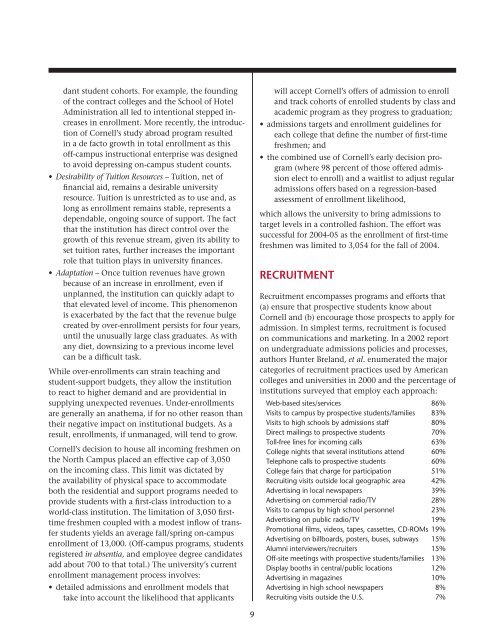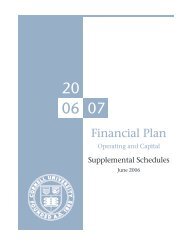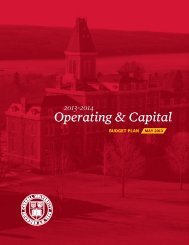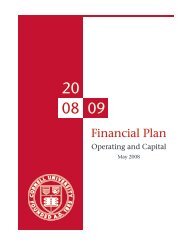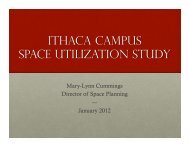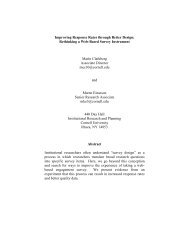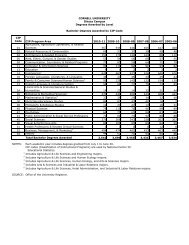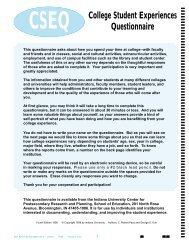Undergraduate Student Access - Cornell University Division of ...
Undergraduate Student Access - Cornell University Division of ...
Undergraduate Student Access - Cornell University Division of ...
You also want an ePaper? Increase the reach of your titles
YUMPU automatically turns print PDFs into web optimized ePapers that Google loves.
dant student cohorts. For example, the founding<strong>of</strong> the contract colleges and the School <strong>of</strong> HotelAdministration all led to intentional stepped increasesin enrollment. More recently, the introduction<strong>of</strong> <strong>Cornell</strong>’s study abroad program resultedin a de facto growth in total enrollment as this<strong>of</strong>f-campus instructional enterprise was designedto avoid depressing on-campus student counts.• Desirability <strong>of</strong> Tuition Resources – Tuition, net <strong>of</strong>financial aid, remains a desirable universityresource. Tuition is unrestricted as to use and, aslong as enrollment remains stable, represents adependable, ongoing source <strong>of</strong> support. The factthat the institution has direct control over thegrowth <strong>of</strong> this revenue stream, given its ability toset tuition rates, further increases the importantrole that tuition plays in university finances.• Adaptation – Once tuition revenues have grownbecause <strong>of</strong> an increase in enrollment, even ifunplanned, the institution can quickly adapt tothat elevated level <strong>of</strong> income. This phenomenonis exacerbated by the fact that the revenue bulgecreated by over-enrollment persists for four years,until the unusually large class graduates. As withany diet, downsizing to a previous income levelcan be a difficult task.While over-enrollments can strain teaching andstudent-support budgets, they allow the institutionto react to higher demand and are providential insupplying unexpected revenues. Under-enrollmentsare generally an anathema, if for no other reason thantheir negative impact on institutional budgets. As aresult, enrollments, if unmanaged, will tend to grow.<strong>Cornell</strong>’s decision to house all incoming freshmen onthe North Campus placed an effective cap <strong>of</strong> 3,050on the incoming class. This limit was dictated bythe availability <strong>of</strong> physical space to accommodateboth the residential and support programs needed toprovide students with a first-class introduction to aworld-class institution. The limitation <strong>of</strong> 3,050 firsttimefreshmen coupled with a modest inflow <strong>of</strong> transferstudents yields an average fall/spring on-campusenrollment <strong>of</strong> 13,000. (Off-campus programs, studentsregistered in absentia, and employee degree candidatesadd about 700 to that total.) The university’s currentenrollment management process involves:• detailed admissions and enrollment models thattake into account the likelihood that applicantswill accept <strong>Cornell</strong>’s <strong>of</strong>fers <strong>of</strong> admission to enrolland track cohorts <strong>of</strong> enrolled students by class andacademic program as they progress to graduation;• admissions targets and enrollment guidelines foreach college that define the number <strong>of</strong> first-timefreshmen; and• the combined use <strong>of</strong> <strong>Cornell</strong>’s early decision program(where 98 percent <strong>of</strong> those <strong>of</strong>fered admissionelect to enroll) and a waitlist to adjust regularadmissions <strong>of</strong>fers based on a regression-basedassessment <strong>of</strong> enrollment likelihood,which allows the university to bring admissions totarget levels in a controlled fashion. The effort wassuccessful for 2004-05 as the enrollment <strong>of</strong> first-timefreshmen was limited to 3,054 for the fall <strong>of</strong> 2004.RECRUITMENTRecruitment encompasses programs and efforts that(a) ensure that prospective students know about<strong>Cornell</strong> and (b) encourage those prospects to apply foradmission. In simplest terms, recruitment is focusedon communications and marketing. In a 2002 reporton undergraduate admissions policies and processes,authors Hunter Breland, et al. enumerated the majorcategories <strong>of</strong> recruitment practices used by Americancolleges and universities in 2000 and the percentage <strong>of</strong>institutions surveyed that employ each approach:Web-based sites/services 86%Visits to campus by prospective students/families 83%Visits to high schools by admissions staff 80%Direct mailings to prospective students 70%Toll-free lines for incoming calls 63%College nights that several institutions attend 60%Telephone calls to prospective students 60%College fairs that charge for participation 51%Recruiting visits outside local geographic area 42%Advertising in local newspapers 39%Advertising on commercial radio/TV 28%Visits to campus by high school personnel 23%Advertising on public radio/TV 19%Promotional films, videos, tapes, cassettes, CD-ROMs 19%Advertising on billboards, posters, buses, subways 15%Alumni interviewers/recruiters 15%Off-site meetings with prospective students/families 13%Display booths in central/public locations 12%Advertising in magazines 10%Advertising in high school newspapers 8%Recruiting visits outside the U.S. 7%9


